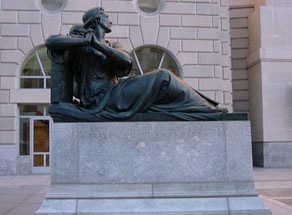
This statue in Washington, D.C. represents religious freedom. It is inscribed with the quote "Our liberty of worship is not a concession nor a privilege, but an inherent right."
The earliest settlers of America came in search of religious freedom. Centuries later, the United States is still seen as a land where hope and freedom, including the freedom of religion, exist for those who seek them.

This statue in Washington, D.C. represents religious freedom. It is inscribed with the quote "Our liberty of worship is not a concession nor a privilege, but an inherent right."
→ Quick Reflection: Many of the early American settlers agreed with this quote. Do you agree? Why or why not?
In this section, you will trace the development of religion in America beginning in the 17th century. To understand how religion in America progressed, we must understand the practice of religion in England. Here are some important points to remember:
|
Religious groups and individuals from England and from other nations migrated to the American colonies in order to adhere to their religious beliefs and practices without fear of persecution. Thus, the desire for religious freedom became characteristic of religion in America during the 17th century.
The Puritans were a religious group who grew displeased with the Church of England and worked toward religious, moral, and societal reforms. They felt the Church of England had become too political and filled with man-made rules. Eventually they faced persecution, and some began to leave England in search of religious freedom. Their search led them to America.
Puritanism, in part, involved the belief that the Bible was God's true law and that it provided a plan for living. They wanted to "purify" the church and their own lives. They settled initially in Massachusetts with the purpose of building a holy community where they could live good lives according to the rules of the Bible. They wanted their colony to be an example to the world.
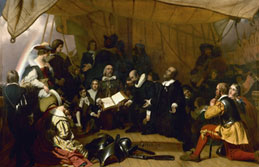
In the painting Embarkation of the Pilgrims (1857), the Pilgrims, a sect of the Puritans, are pictured planning for the new colonies while still aboard the Mayflower.
Scroll over the names of Anne Hutchinson, John Winthrop, and and read about how they each impacted the Puritan development in the early settlement of the United States.
The Quakers, though different from the Puritans, were another religious group that sought religious freedom in the 17th century. Like the Puritans, the Quakers suffered persecution in England, but their experience in the American colonies was different. It was the Puritans who persecuted the Quakers in the colonies. The Quakers were also called "The Society of Friends." They had different beliefs and religious practices that other people didn't understand.
Some Characteristics of the Quakers |
|
In your notes, answer the following questions.

One of the most important Quakers wasInteractive popup. Assistance may be required. . Following his beliefs, he visualized a society filled with peace, equality, and toleration. Penn wanted to create a society that respected all religions and treated all people as equals. Penn founded Pennsylvania so that Quakers would have a refuge of safety.
.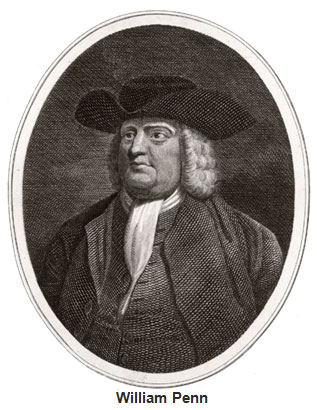
William Penn came from a prominent English family. He was an entrepreneur and owned large amounts of real estate. Even though it was dangerous, he became a Quaker. When he realized that religious freedom in England could not be achieved, he sailed to America to claim land that was given to him by the King (to satisfy a debt to Penn's father). Penn founded the colony of Pennsylvania.
Remember that Catholicism was not allowed in England. Much like the other religious groups, Catholics came to America in search of religious freedom and a place to worship freely. The Catholics settled in the colony of Maryland. It was founded by George Calvert who was originally given a charter to start the colony by King Charles I in 1629. Calvert founded Maryland on religious freedom, but he also wanted the citizens of his colonies to live good and prosperous lives.
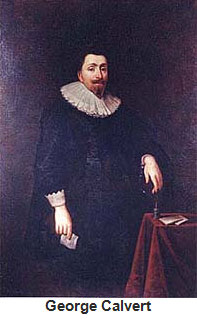
In 1649 the colony passed the Maryland Toleration Act. This act was meant to protect Catholics who were in the minority in this colony. The act was also meant to encourage the settlement of more Catholics in the area. The freedom of religion in Maryland was only for Christians. As a result of the act, anyone who did not believe in Christ would be killed. This meant that Jews and atheists (people who do not believe in God) were not protected. There was harsh punishment for those who spoke against any rules or practices of the Catholics.
People who practiced the Jewish faith experienced persecution in England and in the American colonies. They eventually found a colony that was welcoming and tolerant of their practices. That colony was Rhode Island.
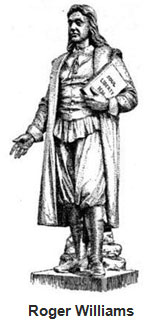
Roger Williams had been a Puritan minister who was seeking a pure, religious community. He grew discouraged by the intolerance he initially found in the Puritan communities in the colonies. Although he was a Puritan, some of his beliefs set him apart from other Puritans. Williams believed in the freedom of conscience, meaning he believed that each person should choose his or her religion.
Roger Williams became one of the founders of Rhode Island, a colony whose inhabitants practiced the tolerance of other religions, which was ideal for those who practiced the Jewish religion.
Religion was a serious matter in the 17th century. Although most people sought religious freedom in the American colonies, persecution of religion still existed. In some of the colonies, people of different religions were denied rights such as voting and holding public offices. As the 17th century ended, each of the American colonies began to form their own identities, and religion played a major role.
Sources of images used for this section as they appear, top to bottom: